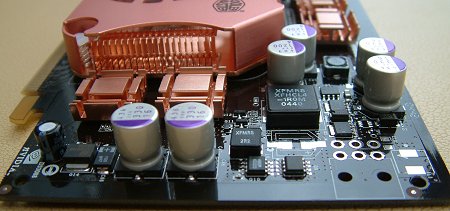Appearance and thoughts
Reference or not to reference, that is the question.
Not to reference, evidently. Inno3D's obviously in cahoots with Cooler Master and has produced a striking GeForce 6600 GT design. Note just how relatively small the PCB is. A better estimation can be made when comparing it to a GeForce 6800 Ultra. There will be no problem in housing it in a SFF system (PCI-Express slot permitting). Leading on from that, current GeForce 6600 GTs are only available with a PCIe X16 interface, supported natively. We're still waiting for bridged AGP designs to hit the shelves, so only consider it if you're moving on to the very latest AMD and Intel motherboards. The back of the card is generally bare. There's no video-in functionality here.
The little notch at the top is reserved for NVIDIA's Scalable Link Interface, better known as SLI, that allows for two compliant boards to be hooked up in tandem on SLI-certified motherboards. If you're old enough to remember SLI'd Voodoo 2s from the now-defunct 3dfx, you'll know where the basic technology comes from. NVIDIA optimistically reckons that two 6600 GTs in SLI formation offer up to twice the power of a single card. That's true in very limited scenarios, but reported gains range from around 50% through to 70%. The question is, would you rather have 2 6600 GTs in SLI mode or a single 6800 GT?. Ryszard is busy answering that kind of question right now.

A look at the front shows a generous helping of copper for both GPU and RAM heatsinks. CoolerMaster's elegant-looking heatsink's fan is a touch on the noisy side when compared to, say, MSI's Radeon X700 PRO's cooler. However, it's only likely to cause aural irritation in the quietest of systems. The GeForce 6600 GT's 500MHz core is the highest speed of any NV4x part. That's been achieved in a two-fold manner. Firstly, the 6600 GT is fabbed on TSMC's 110nm manufacturing process; the 6800's still based on 130nm tech. Secondly, some additional heat has been taken out of the basic NV40 design by having a transistor-saving 128-bit memory bus and 'only' 8 rendering pipelines and 4 accompanying render outputs. More on these later. PCI-Express' X16 protocol gives enough power to allow Inno3D to do without having to use external connector.

The use of RAMsinks isn't necessary at stock speeds. Inno3D's 6600 GT is clocked in at a default 500MHz core and 1GHz memory that's run with GDDR3 DRAMs. It's impossible to ascertain the basic speed rating of the underlying 128MB video memory without prizing off the heatsinks, but I'd imagine Inno3D's followed the crowd and opted for 4x256Mbit Samsung 2ns GDDR3 chips. Overclocking should be impressive.

S-Video that's good for outputting video signals, DVI-I and HD15 make their usual appearances on the back panel. Inno3D's 6600 GT is pretty much what we'd expect from a retail board. It's small, generally quiet, and certainly looks the part.









